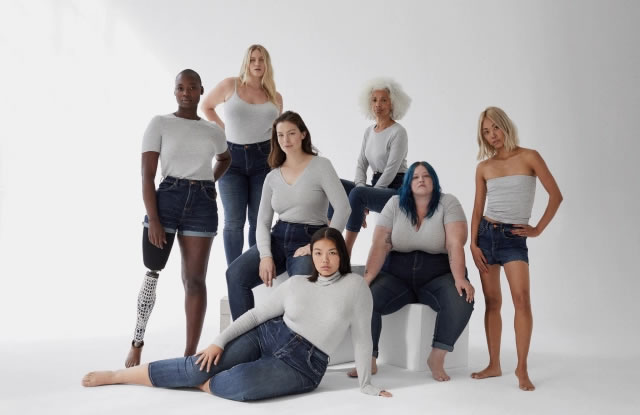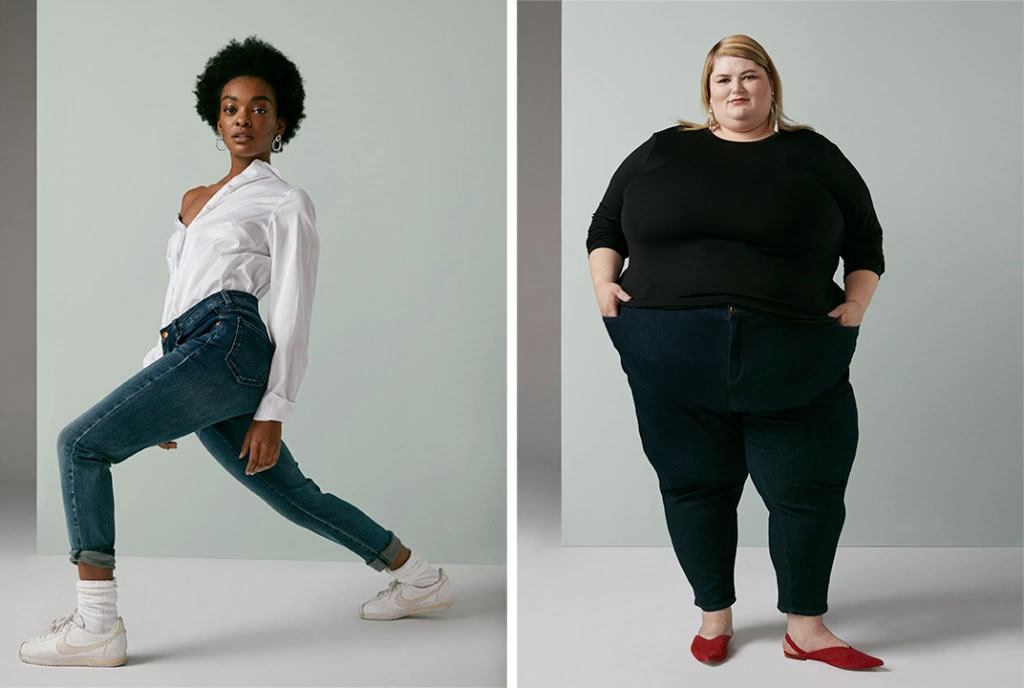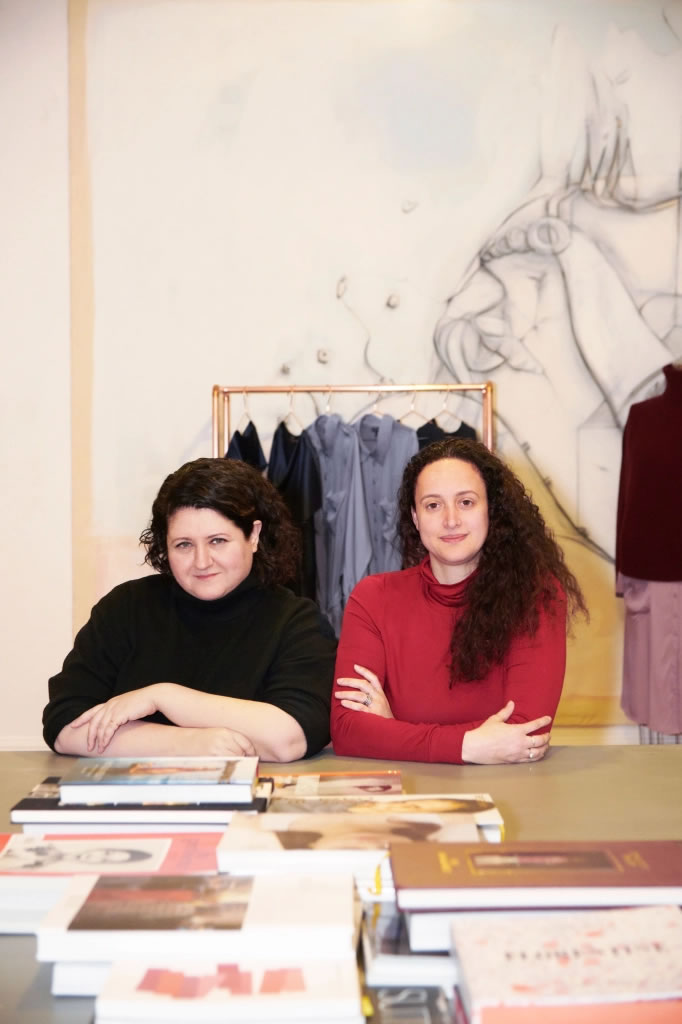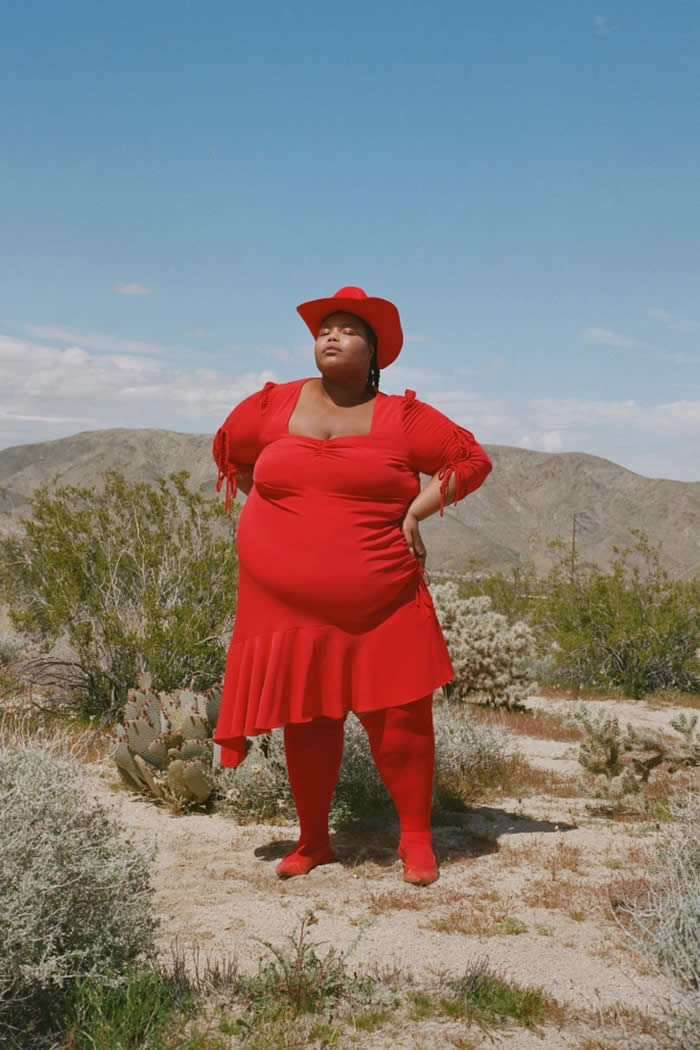The socially conscious consumer. We hear about her all the time, as increasingly shoppers want to buy from brands they perceive as good corporate citizens.
Yet when it comes to fashion, not all women have the option of shopping where their environmental values are. So says Alexandra Waldman, creative director and cofounder of Universal Standard. Waldman refers to the millions of American women who don’t fit into fashion’s single-digit size ideal, those whom she and her partner Polina Veksler determined to include when founding their company in 2015. (The brand’s initials allow for a pointed tagline: “All of US. As we are.”)
Waldman is one of those women. She describes an often excruciating shopping experience that typically leaves little room for big-picture societal considerations. “There is a hierarchy of needs when it comes to dressing yourself, and you have to be practical,” she says. “For the 70 percent of [American] women who are size 14 and above, the hierarchy of needs is, ‘I want to dress in a way that I want to present myself.’ That comes first. ‘I want to dress in a way that I can afford.’ That comes second. And probably third, if at all, is the social activism, where you worry about how the clothes are produced, or how they are thrown out.”

A fashion version of Maslow’s pyramid? Certainly, “clothes” sit near the base of that old, vaunted triangle, but there’s quite a bit of road between whatever makes one not naked and having the perfect pair of jeans. Yet Waldman argues that the comparison isn’t a stretch. “It’s a completely different organization of the pyramid, depending on your size, and it’s a self-perpetuating cycle,” she says. “The whole [fashion] system is set up for incredible inequality, not just in terms of quality and access, but in terms of presentation and representation. It’s a rigged system, and it’s got to change.” A number of major names in fashion and wellness agree. Universal Standard’s investors include Net-a-porter founder Natalie Massenet, Matchesfashion founders Tom and Ruth Chapman, Goop goddess Gwyneth Paltrow, and SoulCycle cofounder Elizabeth Cutler.
Waldman maintains that women who wear sizes 14 and up are overly dependent on fast fashion because that’s the arena most willing to address them. That often forces then to buy well behind trend because those manufacturers tend to assess what has played out across the general market before committing to themes in larger sizes. More globally, it’s extremely difficult for these women to consider environmental concerns. “The more marginalized you are as a consumer in fashion, the more ingrained that order is,” Waldman says.
“If you are someone who has everything available from every brand, you can afford to say, ‘I’m not going to buy from this brand because I care about the environment, and I have all these choices where I can buy the things that I want that cater to those personal beliefs.’ If you are someone who is buying from a handful of brands, most of which are focused on probably the lowest price possible, which usually means the worst possible consequence for the environment, then you are constantly compromising, whether you like it or not.”
Universal Standard wants to chip away at that compromise. Conscious of the goal of a circular economy, Waldman and Veksler became eager to participate on a scale suited to their young company. A recycling program dovetailed nicely with US’ ethos of providing all women the opportunity to buy high-quality clothes that last. The women came up with Reset, Recycle, Refresh, launched in September in partnership with recycling company Marimole.

Customers can purchase a recycle bag from Universal Standard’s web site, fill it with up to four items, send it in to Marimole and receive a $25-per item credit toward US merchandise, with no limit on the number of bags one can send in. The old wardrobe pieces can be any item, from any brand, in any condition. Marimole finds a variety of second-life options for the cast-offs, from resale to upcycling into insulation for the auto and aerospace industries. Since the program’s start, Marimole has received 2,000 pounds of goods for recycle.
The brand has a separate endeavor with Blue Jeans Go Green, started in 2017. During US’ annual Denim Drive, shoppers can buy any pair of jeans for $25 — and a promise. Once her purchase arrives, a customer must use the supplied mailing label to send back a pair of old jeans, which will be recycled into building insulation. To date, the program has helped recycle 23,000 pairs of jeans. This year’s drive is on Cyber Monday, Nov. 30.
Such good-citizenship manifestations make sense from a company that considers itself “the world’s most inclusive fashion brand.” All of the company’s styles are available in sizes 00 to 40 — and don’t call any part of that range “special sizing.” Veksler and Waldman reiterate again and again that there should be nothing special about the industry making clothes available to all women, regardless of body type, and that the designs of those clothes should reflect current styles.
Despite that powerful sense of mission, Universal Standard’s founding — as well as its founders’ fashion careers — came about rather by happenstance. The women followed separate international paths to New York City. Waldman, a Canadian, worked as a fashion journalist in Japan before transitioning to the finance world, with stops in Moscow and Paris. (Along the way, she wrote an as-yet unpublished novel, she says, “just to get it out of my system”).
Veksler immigrated to South Florida from Russia as a child, bouncing from New York to Moscow and back during stints in investment banking and at Microsoft. While she has since moved to Seattle, where she lives with her husband and three children, the two women met, introduced by a mutual acquaintance, when both lived in New York. They quickly became friends.
A year went by, however, before the inspiration for Universal Standard struck after Waldman bowed out of a networking-event date for want of something to wear. Veksler suggested a day of major-store shopping together. That led to an “a-ha” moment. She recalls that “we walked by all the beautifully merchandised floors, and in this small little section, Alex said, ‘Let’s find something for me here.’” That section was the depressing “special size” area. “I thought she was kidding.”
For Veksler, “the experience, and what was on offer, was so different than any shopping experience I had ever had.” For Waldman, a size 22, it was a stark and unfortunately reoccurring episode marked by “an abysmal amount of choice.” Waldman explains that she “had a very, very deep understanding of what was missing, not just the lack of options, but in terms of the stuff that was available, why it was terrible, why it didn’t work, the indifference with which these designs were created. I call it the Marie Antoinette way. Like, ‘who cares? Let them eat cake.’”
“Them” are “millions of American women who have been so badly underserved for generations,” Waldman says. “I’ve lived in a large body my entire adulthood and I was keenly aware, both through my own experience and through writing about fashion, what was out there and what was not.”
Out there: plenty of T-shirts decorated with puppies and kittens. Not “out there:” core wardrobe-building pieces that exude a sense of chic. Universal Standard launched with eight such items, essentials to which all women should have easy access: a skirt, jacket, work dress, work top, casual top, sweatshirt, coat, and the “fantastic” Geneva Dress that remains the company’s bestseller.

Initially, the brand was not fully size-inclusive. It launched with a range of 10 to 28 before expanding to 6 to 32 and, ultimately, the current 00 to 40. When considering why more brands don’t offer such a range, Veksler noted that, in addition to fashion’s long-running lack or regard for women of size, maintaining such an expansive range across all products is “very, very hard,” with challenges running the gamut from ensuring uniformity of fit and fabric to finding factories with sufficient production capacity. Inventory planning is also a hurdle, though thanks to Universal Standard’s d-to-c model, the women have keen insight into their customers’ needs and preferences. Data analytics are a crucial part of the process, with Veksler processing and interpreting the numbers herself.
“Our repeat-purchases rates are through the roof, and that has really helped propel our business,” she says. “Because of that strong consumer data, because of being able to understand how T-shirt X performed, it’s much easier to understand how T-shirt Y is going to perform.” Small weekly drops — often, a drop is a single item — keep product fresh. Once women discover Universal Standard, the partners maintain, they keep coming back.
The company is relentless in its messaging about its focus on quality and style for all. That, and the fact that the Universal Standard customer knows with certainty that she can find something in her size on the brand’s web site, carries tremendous psychological value. Indeed, while Universal Standard aims to sell its customers great-looking clothes, it actually offers something loftier: access to a world once closed off to many. “People like me,” Waldman offers, “[should be able] to walk into a store in SoHo and buy something more than a scented candle. I love design. I love fashion. Ask me how many times I go into the Gucci store. There is nothing for me in there, and it’s actually soul-crushing.”
Universal Standard’s aesthetic hews toward understated chic. Yet the brand is committed to providing women access across all areas of wardrobe need, from fitness wear to major fashion. Collaborations make an important part of its strategy, and again, the goal runs deeper than the obvious, in this case, enjoying the buzz such pairings attract.
Veksler and Waldman maintain that given the knowledge they’ve gleaned about fit and sizing, they can help other companies become more inclusive. “The driving idea behind our working with diverse brands is to be a change agent in the industry, and to use collaborations as a tool for establishing a new normal,” say Waldman. Recent high-profile collaborations include those with J. Crew, in 2018, and in 2019, Rodarte and Adidas.
Such projects are but one of the company’s sub-strategies intended to address the complicated emotions women experience when merely getting dressed. Another, Fit Liberty, takes insightful marketing to a new level. The program allows the customer to exchange items under the Fit Liberty moniker within a year of purchase for the same pieces in a different size.
Waldman explains that she and Veksler “have watched grown women have entire conversations with the bully in their heads: ‘I’m a medium, but I’m going to be a small. I became a vegan yesterday, so I’m going to be Naomi Campbell in a week.’” Those conversations impact how women shop, sometimes keeping them from investing in quality purchases, and sometimes resulting in that “goal” purchase that languishes in the closet.
Fit Liberty seeks to change that behavior. The client purchases an item that fits and looks great now, without fear that it will turn useless when her inner Naomi emerges (or she gains a few pounds). The program, Waldman says, offers “a psychological and emotional salve for a lot of women who have been beaten over the head for their entire lives about their size and what it should be.”
Fit Liberty returns are donated to Dress for Success and the First Step initiative of Coalition for the Homeless, just one of Universal Standard’s charitable endeavors.
At the height of the first wave of the COVID-19 pandemic, the brand gifted over $500,000 in clothes from Foundation, its collection of tops, bodysuits and dresses in a super-soft, micro-ribbed fabric. It financed half the project, and its customers, the other half, via a buy-one-give-one initiative. US also gave out 10,000 “Geneva Dresses” to stressed working moms on Mother’s Day.
The brand also released a children’s book, “What Would Fashion Look Like If It Included All of Us?,” with proceeds donated to #SaveWithStories, an initiative of Save the Children and No Kid Hungry. More recently (admittedly inspired by a similar move by MM.LaFleur), Universal Standard offered to dress women and non-binary candidates running for office in 2020. (In case you wonder, Republicans were welcomed. The offer was non-partisan.) And the two women are deeply committed to Planned Parenthood and LGTBQ inclusion. Says Waldman, “We are not afraid to wear our hearts on our sleeve.”
To that end, Universal Standard isn’t only about size availability. It seeks to facilitate a shift in the way the culture perceives and treats women based on their size, with fashion playing a major role. The industry, Waldman says, “was speaking two different languages to women who are influenced by the same shows, walking past the same windows, reading the same magazines. They were having completely different conversations.” A rigged system ripe for change, and Universal Standard is leading the way.


